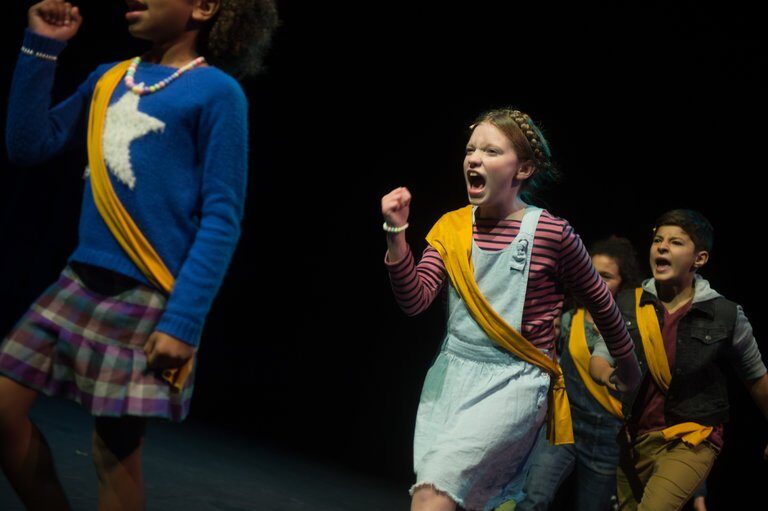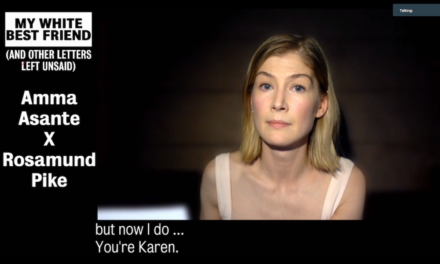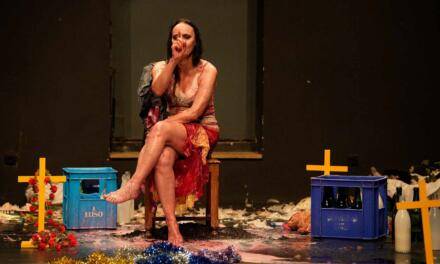The Philadelphia Fringe Festival, now in its twenty-first year, has been gentrified. What began in 1997 as a loose network of scrappy local arts groups presenting sixty-odd pieces in Philadelphia’s Old City district over five days has grown into a seventeen-day affair that imports international avant-garde superstars like Romeo Castellucci and Ivo van Hove to present curated productions in state-of-the-art, higher-capacity venues, while over a thousand uncurated performances now take place in basements and bars from Fishtown to Manayunk to Queen Village. As always, gentrification comes with certain tradeoffs. The roving Fringe Bar, which once consisted of dirty floors and well whiskey served in plastic cups has become La Peg, a multi-level restaurant that serves oysters, duck prosciutto, and “country-fried quail” year-round, while performance work in various stages of development is presented in the adjacent theater space several times per month. Production budgets have gone up, attracting more “world class” talent, whatever that means. Ticket prices have gone up accordingly, thus presenting obstacles for those artists and audience members from less privileged classes. The most visible aspects of the festival are more grown-up, more refined, more financially stable, and safer in the sense that the headlining acts often have multiple decades of experience producing award-winning work under their belts.
But artistic safety should not necessarily be the overriding consideration of a festival that prides itself on celebrating the unconventional, the innovative, and (as the appellation “fringe” suggests) the simply marginal. It is, therefore, my pleasure to report that much of the most invigorating work at the 2017 Fringe Festival was still both trenchantly experimental and homegrown. With the threat of nuclear war with North Korea dominating the headlines and one disastrous September hurricane after another heightening anxieties about the coming climate change apocalypse, however, it seemed appropriate that themes reflecting a certain ambivalence towards the physical safety of future generations and the future itself would dominate this year’s festival offerings.
Pig Iron Theatre Company: A Period of Animate Existence

A Period of Animate Existence. Photo: Maria Baranova
Pig Iron Theatre Company, responsible for many deliciously delirious highlights of Fringe Festivals past, presented A Period of Animate Existence, a conceptually ambitious work of “symphonic theater” about life in the age of the Anthropocene, the proposed term for the present geological epoch, marked by significant (and deleterious) human impact on the earth’s ecosystems. Directed by Dan Rothenberg with a powerful, eclectic score by Troy Herion, A Period of Animate Existence attempts to wrestle the overwhelming facts of humankind’s implication in the planet’s annihilation down to a human scale. It does so in five stylistically distinct “movements,” each conjuring different possible emotional valences and attitudes toward our present situation. One, starring an apparently sentient halal cart, fantasizes with a certain cold, technophilic optimism about the possibilities of a future free of flesh and blood. “Humans,” the halal cart tells us, “are the reproductive organs of machines.” The longest movement features a chorus of children and a chorus of elders joining forces to put on a charmingly rough-hewn “pageant” about the dying earth that employs a series of sets on wagons, borrowing aesthetically from both the religious pageants of medieval drama and the sorts of pageants contemporary elementary school students put on for indulgent relatives. This might be the most conventionally poignant section, concluding with the death of the “last grandmother” and a dozen children shouting directly at the audience, beseeching us to remember them. “Save our home,” they demand, “don’t destroy our future.” Another section consists of a strangely soothing song about the ultimate insignificance of the human species in the great flux of time: “Something always was / Something always will be / Let that set you free.” Other sections are less effective, and the piece does not handle the potentially interesting dissonance between the five movements in a productive way. A Period of Animate Existence wants to be Einstein on the Beach. It isn’t. But it asks questions as vast and unanswerable, and like Robert Wilson and Philip Glass’s masterpiece, it succeeds in charting authentically new emotional territory.
Marc Bamuthi Joseph and Daniel Roumain: We Shall Not Be Moved
Disappointingly, Marc Bamuthi Joseph and Daniel Roumain’s We Shall Not Be Moved does not. This highly anticipated new opera, directed by the much-lauded Bill T. Jones, purports to deal with the contested legacy of the MOVE organization, the radical group whose West Philadelphia row house was bombed by the police in 1985, resulting in the deaths of eleven people and the displacement of dozens of African-American families. Except that it doesn’t actually attempt to deal with MOVE, the fascinating and problematic characters of its founders, their police antagonists, and the city officials who to this day have not managed to adequately repair the damage to the bombed street. Joseph’s libretto instead asks us to follow five contemporary disenfranchised black children (one of whom is unaccountably white, all of whom are played by adults) who get into trouble and flee to the abandoned MOVE headquarters to hide out and commune with the spirits of the children who died in the bombing (largely silent dancers in hoodies). There they learn that America hates black people.The aesthetic premise of We Shall Not Be Moved is an exciting and important one: Roumain’s score fuses classical music, R&B, and spoken word in an attempt to open up this notoriously hidebound form not only to new musical possibilities but to new voices, new perspectives. Can opera, with its reputation for elitism and exclusivity accommodate the experiences of the marginalized, Roumain asks. Can it be used to tell black stories? I am confident that it can, but this particular experiment does not convincingly make that case, mostly because Joseph’s libretto lacks both poetry and dramatic structure, and ultimately becomes a pulpy, generic screed against racism. The mezzo soprano’s lyrics jangle with the occasional, awkwardly sung slang phrase about her “ghetto” upbringing and the spoken word artist shakes her finger in our faces and condemns us for our “silence,” which I suppose is what passes for activism these days. A politically progressive opera that succeeded in drawing nuanced parallels between contemporary and historical injustice and that found ways to bend the operatic form to fit urban speech patterns rather than the other way around would have been a welcome and extraordinary thing to witness. However, while Roumain does deliver one or two devastating melodies, We Shall Not Be Moved ultimately feels like a series of shortcuts and missed opportunities.
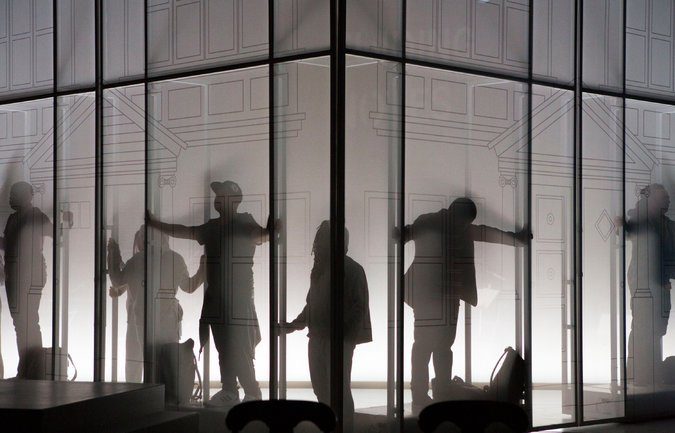
We Shall Not Be Moved. Photo: Jessica Kourkounis
Geoff Sobelle: Home
If the MOVE house almost becomes a character itself in We Shall Not Be Moved, serving as an uneasy (and vocal) refuge for its protagonists, a house is the protagonist in Geoff Sobelle’s Home, which features the most masterful and compelling instance(s) of audience participation this critic has ever seen. Sobelle, who has previously made dazzling use of unsuspecting spectators in his solo piece The Object Lesson, here joins forces with a cast of six that includes a remarkably precocious young boy, director Lee Sunday Evans, and set designer Steven Dufala. Together Sobelle and the other performers construct a full-size home onstage before our eyes and set about occupying it, performing everyday tasks like making the bed, watching television, and taking out the trash. As time passes, these actions become more charged with portent and emotion. A stricken woman comes home with a child in tow, both dressed in funeral finery. An office is converted into a nursery when a man builds a crib for an infant we never meet. All of this business is conducted in silence, all perfectly pedestrian and recognizable, yet somehow elevated by the elegance of the performers’ skilled mime work. They barely interact, never quite congealing into a family unit or any other recognizable domestic arrangement. It is as if each lives alone, all of them obliviously brushing past one another in the nude on the way to the shower.
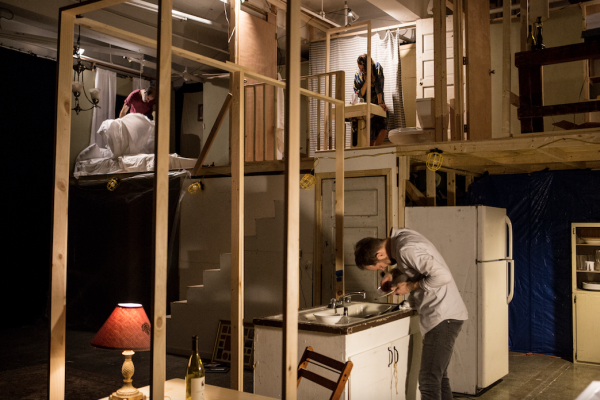
Home. Photo: Maria Baranova
Then all at once, they come together for what appears to be a dinner party, and everything changes. The young boy comes out into the auditorium and invites a spectator to join him. Armed with a bottle of wine, the newest addition to the cast (co-director of Philadelphia’s Headlong Dance Theater David Brick on the night I attended) joins the others onstage, and through the dexterous and discreetly whispered directions Sobelle and other cast members provide the spectator is fully absorbed into the proceedings, helping to pour drinks, set the table, and make merry with apparent comfort and confidence. Soon another spectator is invited onstage, then another and another until the number of spectators onstage far exceeds the number of performers. But the distinction soon becomes practically meaningless. Costumes appear and the party turns into a graduation reception, then a wedding, then a Halloween party, then finally a big, boozy, bacchanal with people dancing in the kitchen and on the dining room table and the entire audience remaining in the auditorium enlisted to help string up two long strands of festive lights stretching from the proscenium to the back wall of the theater, ensuring that all but the very most recalcitrant become participants.
Not all of the spectators-turned-performers looked as preternaturally at ease onstage as, say, Brick, a professional dancer and choreographer, but not a single participant ever seemed lost, humiliated, or coerced, the most common modes in which we see “volunteers” from the audience at the theater. When their ranks swell to more than twenty the spectacle begins to seem perhaps a bit more chaotic and unfocused than is entirely wise or necessary, but on the whole it is a truly astonishing and joyful thing to behold. Home offers an occasion to consider what role our living spaces play in our emotional lives, whether and how they make us feel safe, secure, taken care of. The one child in Home is emphatically not well taken care of (he gets drunk while no one is watching over him at the party), but he takes marvelously good care of the many audience members he assumes responsibility for as a prompter and guide, and in the end, Home is welcoming to all.
New Paradise Laboratory: Hello Blackout!
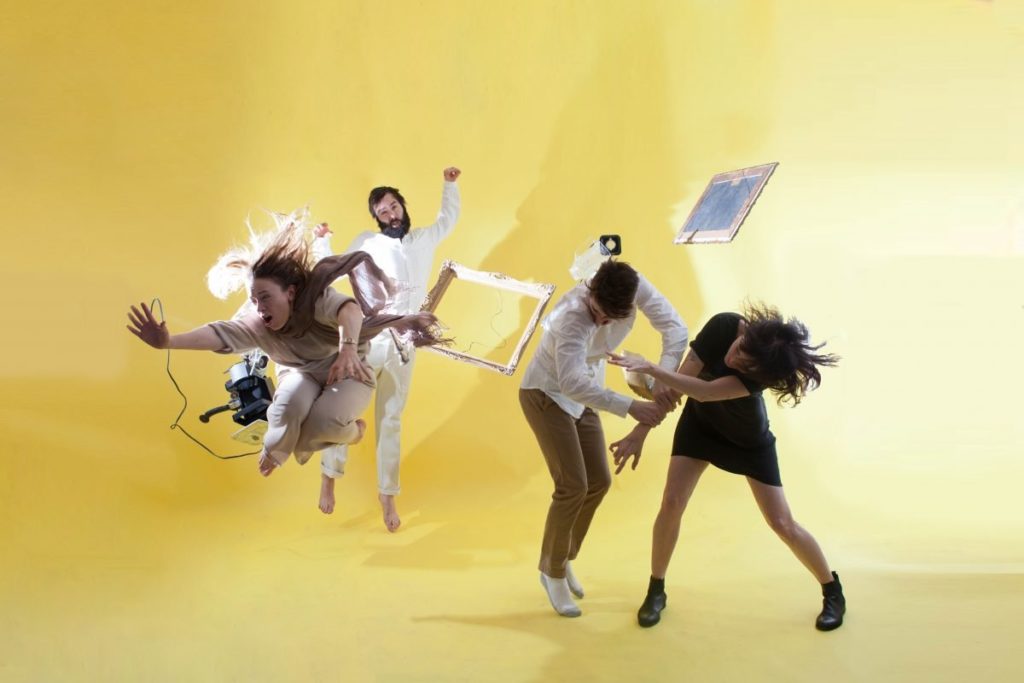
Hello Blackout! Photo: Jake Al-Dookhi
The same cannot be said of New Paradise Laboratories’ ultra-hermetic Hello Blackout!, which grapples with the limits of knowledge and understanding by plunging the audience into literal and metaphorical darkness. In Hello Blackout! Whit MacLaughlin achieves something nearly every other aboveboard theater director in the history of the modern fire code has failed to do—he has gotten permission to turn off those obnoxious illuminated EXIT signs, giving him access to the sort of obscurity most auteurs can only fantasize about. Hello Blackout! aims to estrange rather than ingratiate. Five performers begin the play as mantled figures erratically convulsing to the aggressive accompaniment of an onstage string-dominated quintet. Center stage, an eerie green slice of hallway spits tennis ball-sized objects at the performers at alarming speeds. Chairs and books emerge from the same orifice, only to be mysteriously withdrawn. The performers eventually re-outfit themselves as a royal family of sorts. A king, a queen, and their triplets (two men and one woman) recite elliptical texts inspired by the threat/promise of the patriarch’s assassination. Associations from King Lear to Ivanka, Don Jr., and Eric are made available to us, but Hello Blackout! is insistent in its indeterminacy. The piece asks us to imagine ourselves at a kind of ground zero of certitude. Nothing is known here. Desire exists in this universe, to an extent. So does aggression. So does wonder. But there is no discernible sense of what we might be able to domesticate or wish to pass on to those who come after us.
Sam Tower: Strange Tenants
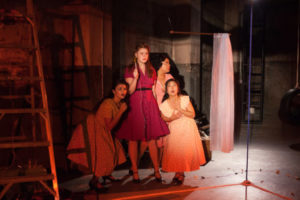
Strange Tenants. Photo: Kate Raines
Relative newcomer Sam Tower’s Strange Tenants is an auspicious take on many of these same questions of inheritance, safety, and care, the important difference being that her project is a violently feminine fractured allegory about what it means to be charged with the responsibility for being the physical bearers of the next generation. It is the 1950s. Four childhood girlfriends reunite at the family home of an unseen fifth old chum in order to reconnect and sort through some unfinished business from the past. Casual banter about husbands, fiancés, and children quickly becomes viciously competitive and accusatory, and one by one each of these nice girls with pearls is revealed to be carrying a shameful secret—lesbian tendencies, ovarian cancer, a kidnapping, an abortion. Each has in her own unique way failed miserably at being a mother, and therefore at being a woman, according to the standards of the era. Unable or unwilling to be hospitable to those “strange tenants” society expects their wombs to play host to, the women are quietly collapsing behind their rouged and coiffed facades. Expressionistic movement sequences set to Alec MacLaughlin’s discordant music allow the women direct, often grotesque access to their feelings of self-loathing and the near-homicidal hatred women are trained to feel towards each other in a society where they are powerless and pitted against one another in competition for scarce resources. These gestures occasionally go too far (I could have used, for example, about thirty seconds less of the “crotch-scratching dance”), but they create intriguing shifts in mood and tone as the piece careens from menacing to campy to uncanny. Late in the play, Tower and her collaborators in this devised work feel compelled to tie up all of the (many) remaining loose narrative threads, and they do so in a single dangerously overstuffed scene. It remains to be seen what role this talented young director will determine conventional narrative structure should play in her work, but she certainly has a flair for the richly evocative image, for a dramaturgy of insinuation. In Strange Tenants, Tower relies on period silhouettes and punctilios that in the end she probably doesn’t need to conjure the horror femininity still inspires in men and women alike, and I look forward to her next bracing contribution to feminist performance.
This post was written by the author in their personal capacity.The opinions expressed in this article are the author’s own and do not reflect the view of The Theatre Times, their staff or collaborators.
This post was written by Jessica Rizzo.
The views expressed here belong to the author and do not necessarily reflect our views and opinions.

